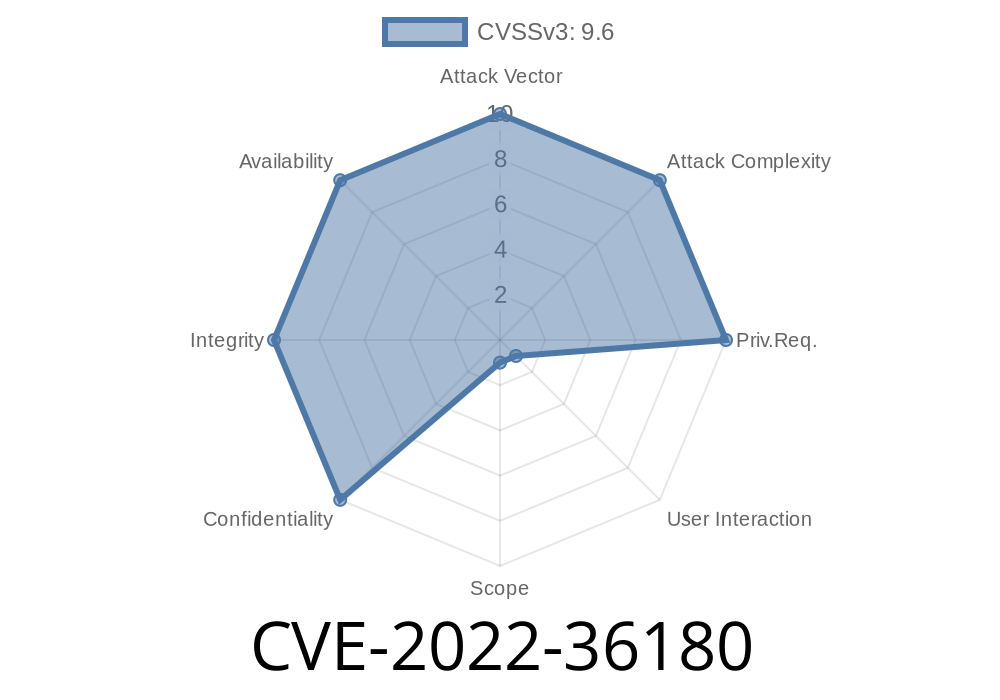FusionDirectory, the popular open-source directory management solution, has recently been found to be vulnerable to Cross-Site Scripting (XSS) attacks. The vulnerable version is FusionDirectory 1.3. The vulnerability has been assigned the identifier CVE-2022-36180. In this post, we will discuss the exploit details and provide guidance on how to address this security issue.
Description of the Vulnerability
Cross-Site Scripting (XSS) is a common web application security vulnerability that allows an attacker to inject malicious scripts into web pages viewed by other users. These scripts can steal sensitive information, perform actions on behalf of the user, and compromise the security of the web application.
The XSS vulnerability in FusionDirectory 1.3 can be exploited through several entry points - specifically, the 'message' parameter located in the application's 'index.php' file:
1. /fusiondirectory/index.php?message=[injection]
2. /fusiondirectory/index.php?message=invalidparameter&plug={injection}
3. /fusiondirectory/index.php?signout=1&message=[injection]&plug=106
To exploit this vulnerability, an attacker can inject arbitrary JavaScript code into the 'message' parameter, potentially compromising the security of the web application and its users.
Code Snippet
Below is a code snippet demonstrating how the injected JavaScript payload can be executed within the browser when a user visits the malicious URL:
<!-- Malicious URL with the injected JavaScript payload -->
<a href="/fusiondirectory/index.php?message=%3Cscript%3Ealert('XSS%20Vulnerability%20in%20FusionDirectory%201.3')%3C/script%3E">Visit this link to trigger the XSS exploit</a>
<!-- Displaying the injected message -->
<?php
$message = $_GET['message'];
echo "<p>Message: " . htmlspecialchars($message) . "</p>";
?>
Replace %3Cscript%3Ealert('XSS%20Vulnerability%20in%20FusionDirectory%201.3')%3C/script%3E in the malicious URL with the desired payload.
The vulnerability was initially reported by security researchers on the following platforms
1. CVE Entry: CVE-2022-36180
2. NIST National Vulnerability Database (NVD) Entry
3. Exploit Database Entry
Mitigation Steps
FusionDirectory has not yet released an official fix for this vulnerability. However, administrators can implement the following steps to mitigate the risk of exploit:
1. Sanitize input: Ensure that all user inputs are properly sanitized to prevent the execution of arbitrary JavaScript code. Use of libraries like OWASP's ESAPI can be helpful for server-side input validation.
2. Utilize Content Security Policy (CSP): Implement CSP headers to restrict the execution of unauthorized scripts within the web application. This can help prevent the exploitation of XSS vulnerabilities.
3. Update and patch regularly: Keep the FusionDirectory software as well as the underlying technology stack (web server, PHP, database) up to date with the latest security patches to protect against known vulnerabilities.
4. Monitor logs and user activity: Regularly monitor server logs and web application activity to identify any unusual behavior that may suggest a security breach.
5. Raise security awareness: Train users to be wary of suspicious links and to report any unusual activity within the web application.
By following these steps, administrators can reduce the risk of exploitation of this CVE-2022-36180 XSS vulnerability in their FusionDirectory deployments. As always, it's essential to stay informed of new vulnerabilities and security updates affecting your applications to maintain a strong security posture.
Timeline
Published on: 11/22/2022 01:15:00 UTC
Last modified on: 07/10/2023 16:15:00 UTC
